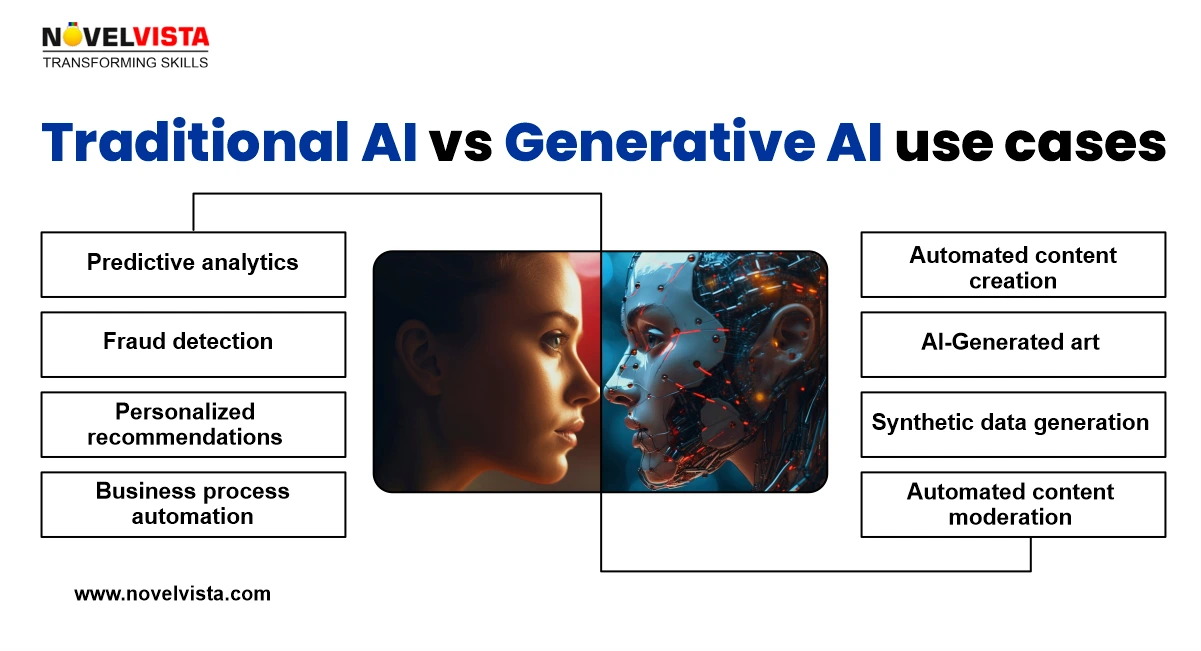Over the last decade, artificial intelligence (AI) has transformed numerous industries and has become an important part of modern technology. Within this vast field, two different branches have emerged, traditional AI and generative AI. What is the difference between AI and generative AI?Both use data and algorithms to complete tasks, but they serve fundamentally different purposes. Traditional artificial intelligence primarily analyses existing data to make predictions and decisions.
Generative AI, on the other hand, represents a more advanced evolution, capable of producing new content by learning patterns from large datasets. This article will look at the key differences between these two types of AI, highlighting their distinct functionalities, applications, and future implications.
Artificial intelligenceis an advanced model of computer science that primarily focuses on creating systems capable of providing faster results than a typical human being. This includes learning, reasoning, problem-solving perception, and language comprehension.
AI seeks to affect human cognitive functions, allowing machines to operate intelligently and autonomously. The difference between AI and generative AI lies in their functions; AI encompasses a broad range of technologies that mimic human intelligence, while generative AI specifically focuses on creating new content, like text, images, or music, based on patterns in existing data.
AI is defined as a simulation of human intelligence. Machines, particularly computer systems, process this with ease. Learning (the acquisition of information and rules for applying it), reasoning (the application of rules to achieve approximate or definite conclusions), and self-correction are examples of such processes.
AI technology is progressively being integrated into numerous applications, from virtual assistants like Siri and Alexa to sophisticated systems in healthcare and finance.
The concept of artificial intelligence dates back a long time. Although important advances began in the mid-20th century. Here are a few examples:
Generative AIis a subdivision of typical artificial intelligence. It majorly focuses on creating new and creative content like texts, audio, videos, and images based on prompts provided by a human. Generative AI makes use of advanced machine-learning techniques especially generative models to learn patterns from existing data and materials.
This approach has gained enough pull in recent years. Deep learning architectures, particularly transformer models, have improved, allowing for the development of large language models (LLMs) and other generative systems.
Understanding the difference between AI and generative AI is crucial for businesses; while AI can analyze data and make predictions, generative AI can produce creative outputs such as designing new products or generating realistic simulations.
Generative AI differs significantly differs from our traditional AI. We have mentioned the basic differences below.

Here are a few examples of generative AI technologies that are shaping the future:
Developed byOpenAI, GPT is a trending large language model that provides consistent and informative results at the click of a button. It provides text-based relevant results based on the prompts provided by the user. They are extensively used in chatbots, content production, and language translation.
DALL-Eis also an intelligent model built by OpenAI. It generates visuals from text prompts given by users. It showcases the capabilities of Generative AI to create high-quality images based on the input given.
Two other noteworthy text-to-image generation models allow users to generate artwork and pictures from descriptive prompts, exhibiting the creative potential of Generative AI.
A text-to-video AI generator that makes videos based on textual input. This shows Generative AI's increasing capabilities in multimedia content creation.
Understanding the differences between traditional AI and Generative AI is important for appreciating their various capabilities and applications. The significant differences across multiple dimensions are outlined below:
When it comes to problem-solving in technology, two distinct approaches are often highlighted, rule-based systems and creative generation.
Choosing between classical AI and Generative AI is determined by the project or application's requirements. Here is a comparative analysis.
The landscape of artificial intelligence is rapidly changing, with substantial advances in both traditional and generative AI.
The convergence of these technologies paves the opportunity for novel applications in a variety of fields. The following are major trends and projections for the future of artificial intelligence and generative AI.
The technology we know of is advancing every day. This section showcases the upcoming trends in this domain.
These systems can understand and generate content in multiple formats, resulting in deeper interactions and better outcomes. They are being developed to handle difficult tasks that require combining several data types.
There is a rising interest in developing smaller, more efficient language models that can function well in contexts where resources are limited. These devices are expected to give competitive performance while also being more accessible for businesses.
The rise of autonomous agents, which can execute tasks and make decisions on their own, is an important trend. These agents use advanced techniques like reinforcement learning and prompt chaining to improve their abilities. This can potentially alter workflows in numerous areas.
The growing availability of generative AI tools via cloud platforms is making these technologies more accessible to companies of all sizes.
🤖 AI vs Generative AI—what's the difference?
🧠 From decision-making to content creation.
To summarize, the primary distinctions between traditional AI andGenerative AIare their approaches to problem-solving, data use, output types, and other applications.
Traditional AI excels in structured activities that need analysis and predictions, whereas Generative AI focuses on creating original content and improving creativity in a variety of fields.
When discussing the difference between AI and generative AI, it's important to note that generative AI is a subset of AI that excels in generating new content, whereas AI in general can include tasks like decision-making, problem-solving, and automation.
The understanding of both AI and Generative AI is important for businesses looking to effectively use their unique skills and remain competitive in this evolving digital world. Accepting these breakthroughs will allow businesses to fully realize the potential of AI in driving growth and transformation.
Confused about our certifications?
Let Our Advisor Guide You